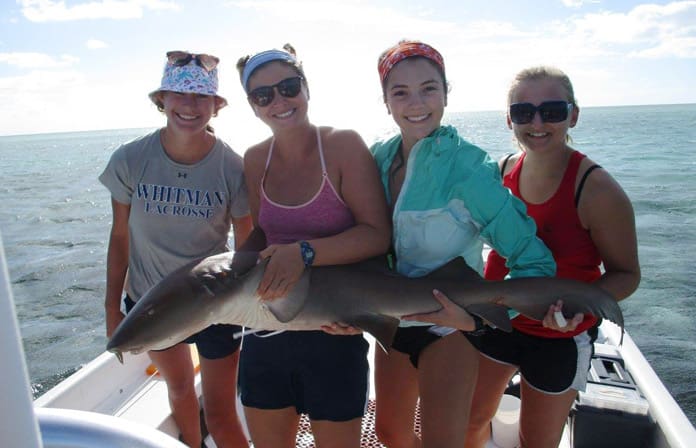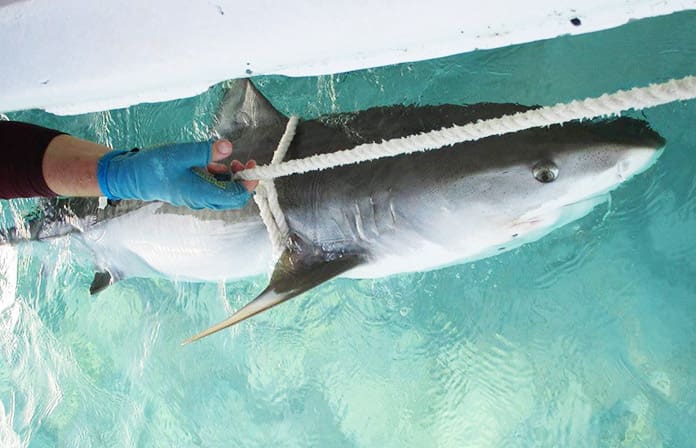June 22, 2017
Alexis Brunz’s education at the University of Montana Western made her uniquely qualified to study nurse sharks in the Caribbean.

The official website for the Turks and Caicos islands is a colorful page full of clear blue seas and floppy palm trees. Pictures of white, rectangular resort hotels and grilled vegetable platters are featured next to glamour photos of the white beaches. This small archipelago between the Bahamas and the Dominican Republic is a relatively untouched stretch of the Caribbean, but the island of South Caicos stands out as the most remote of this isolated chain of landscapes, poking their tiny heads out of the wide, turquoise sea.
Though the website was obviously designed to drive tourism, South Caicos itself is surprisingly undersold. Many of the descriptions of this small island come off as veiled warnings to travellers:
“South Caicos may not be the right destination choice for everyone.”
“…accommodation options are limited…nary a gift shop in sight…beaches aren’t quite up to the standard of the other main islands in the Turks and Caicos.”
While a small handful of adventurers make this their destination, it is certainly no commercialized tourist trap. It’s an unsoiled patch of real wilderness surrounded on all sides by nature. In many ways, it’s quite similar to Dillon, Mont., which Alexis Brunz took note of in our interview. “The small size made it feel familiar, and I would not have enjoyed the adventure as much if the campus was in an urban area. Everyone knew everyone. We got to spend time with the kids and saw the same ones every week, and walking around town felt safe. It felt like a hot, dry, tropical Dillon, which was extremely comforting,” she said.
The campus she mentioned is the School for Field Studies. They are a study-abroad organization that brings environmental science students from around the world into the field to conduct research that will help preserve local habitats. For Brunz, this meant studying nurse sharks in the warm ocean waters 575 miles southeast of Miami, Fla..
Nurse sharks are a fascinating and under-studied species. Although they can grow up to 14 feet in length, they are relatively harmless to humans. Very few attacks have been reported, and none have been fatal. Still, their habit of resting in packs of up to 40 sharks at a time must be a frightening sight for people unaware of their indifference to human flesh.
One hallmark of the nurse shark is the unique slurping sound their cavernous mouths make as they scour the seafloor for hard-shelled animals and small fish. The exact origin of their name is unknown, but some believe it comes from this noise which sounds similar to a nursing baby.

Sadly, Brunz was unable to hear the slurping song of the nurse shark on her trip.
“I did not get to hear the slurping sound the nurse sharks make. It is quiet and hard to record by underwater camera from what I understand. I did get to feel the belly of a pregnant nurse shark though, and that was amazing.”
“There are so many fun facts about nurse sharks. They can use their pectoral fins to ‘walk’ along the sea floor. By becoming less active, the nurse shark can adapt to colder water, which reduces the distance the sharks need to migrate.”
The International Union for Conservation of Nature consider the nurse shark a data-deficient species. This means more research needs to be done to determine how at-risk the species is. Brunz went into detail explaining to me the process of collecting data on the sharks:
“We used a drumline system to hook a shark then tied it to the side of a 24-foot boat to measure and tag. We took the total length (from the tip of the head to the tip of the tail) and clasper length if the shark was male. We inserted a PIT tag, the equivalent of a chip in domestic dogs, and a hard external tag with a number for identification purposes. We took a tissue, blood, and sperm sample. Finally, we would release the shark from the boat and watch it swim away to ensure it was moving properly.”
The University of Montana Western is known for its great environmental studies courses and professors. The block system, along with the location, make the school an ideal place to learn about conservation work. Brunz felt that her time at the school was great preparation for her work in South Caicos:
“I did take a few field courses at UM Western before going to South Caicos. Those helped me realize the hard work and long hours involved in fieldwork and data gathering that many classmates who attend traditional universities did not understand. They also gave me a good work ethic in the field because I understood the faster and harder you go, the more quickly you get to go in and get a drink of ice water.”
Brunz said she had always felt attracted to the ocean, so her work in South Caicos was a bit of a dream come true. “In short, I have always felt a pull to the water, especially salt. I find it crazy we know more about space than the ocean.”
Since her internship, Brunz has fallen even more deeply in love with the ocean. It seems likely that she will continue to travel, studying marine life and finding more and more hidden gems like Dillon, Mont. in islands amid the sea.